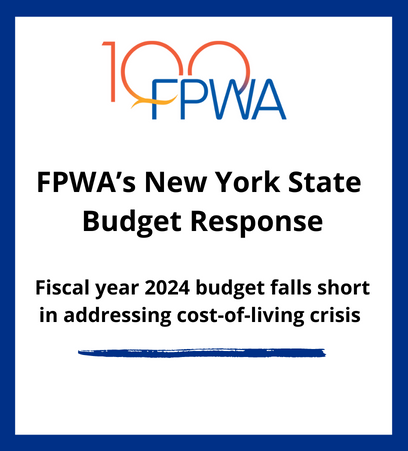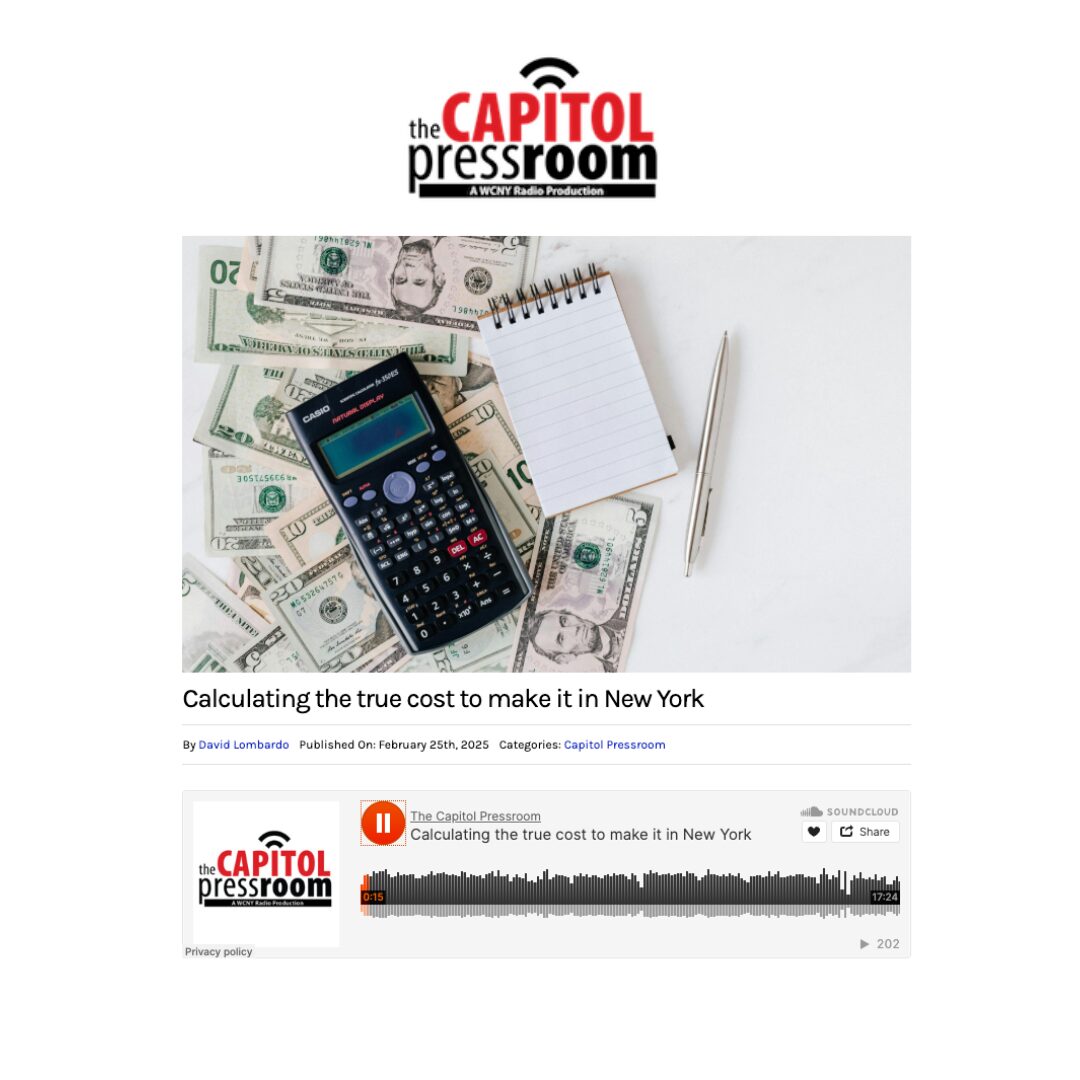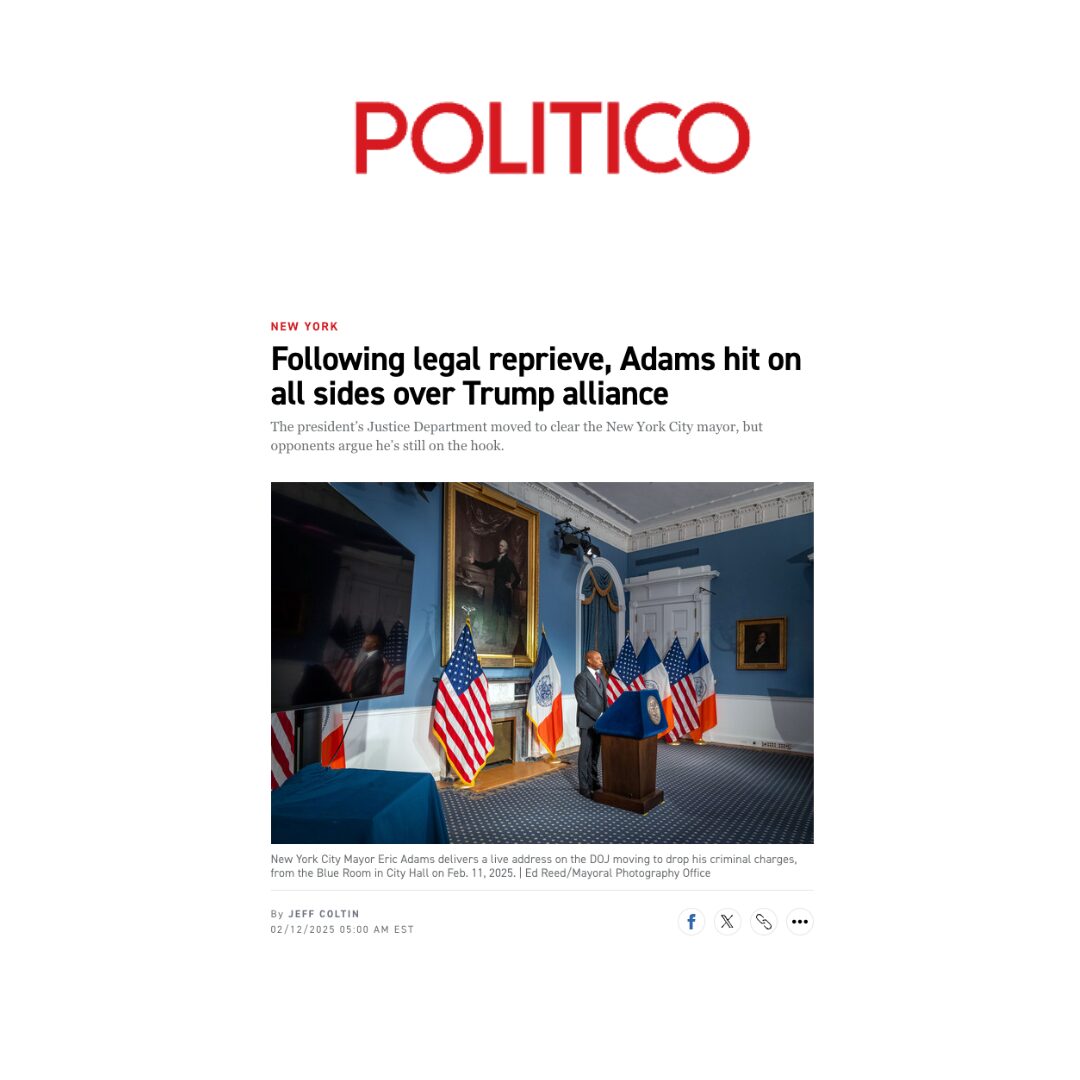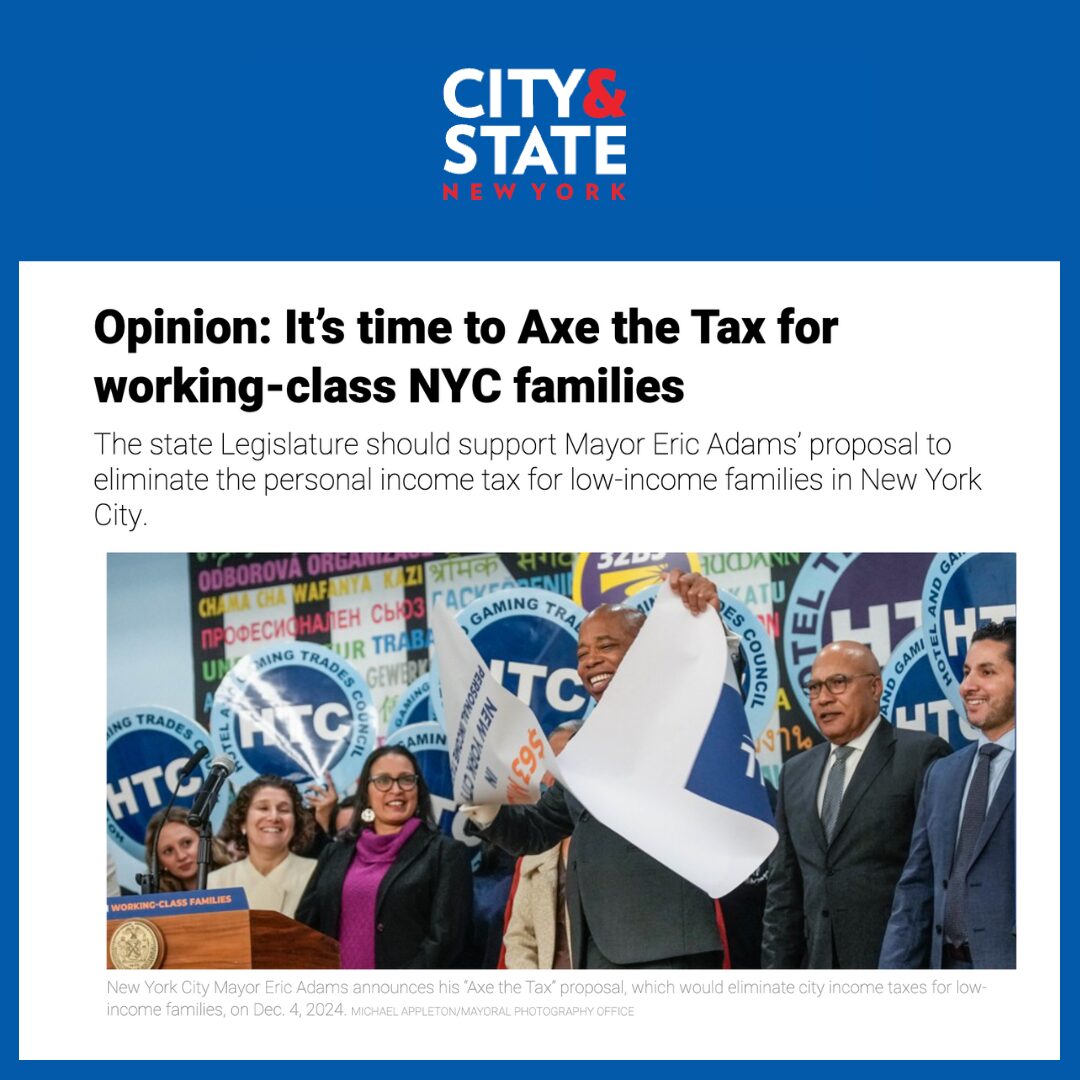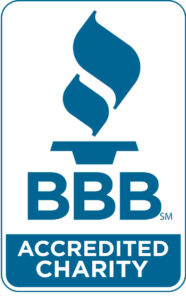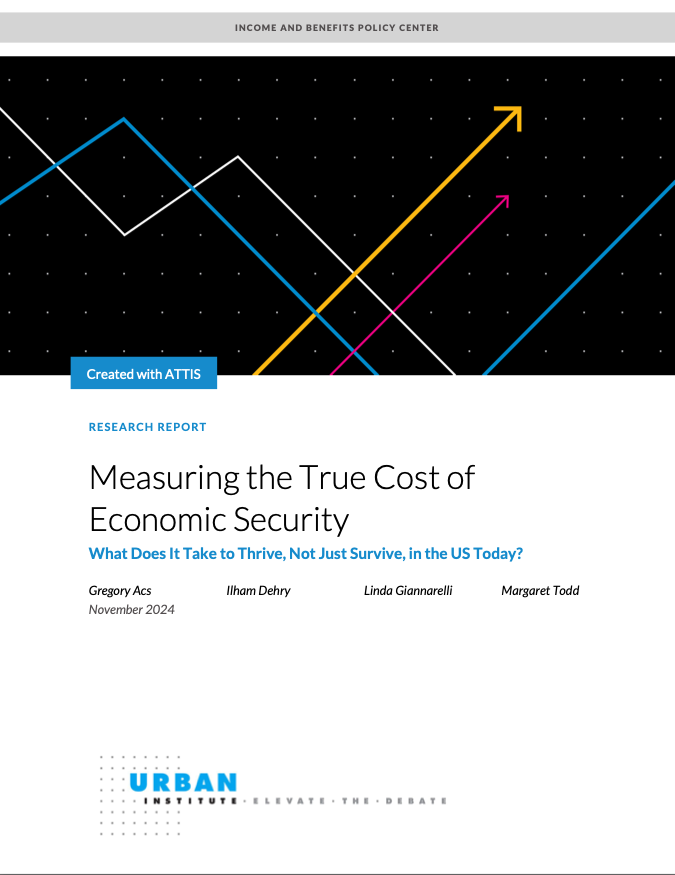For Immediate Release:
May 8, 2023
Contact:
Rachel Noerdlinger,
rnoerdlinger@actumllc.com
Emma Brodsky,
ebrodsky@actumllc.com
Fiscal year 2024 budget falls short in addressing cost-of-living crisis
On May 2nd 2023, the New York State Assembly passed the budget for fiscal year 2024. The $229 billion enacted budget comes in a time of economic uncertainty, with cost-of-living pressures making the year ahead a tumultuous one for New Yorkers, especially those most in need.
Considering this, FPWA supports the inclusion of several key initiatives to support New Yorkers, many targeted toward those with low incomes. These initiatives include:
- $1 billion in funding for mental health services;
- $500 million towards a temporary Workforce Retention Grant Program to better support the undervalued and underpaid workers in the childcare industry;
- An expansion of the Empire State Child Credit to include children under four years old.
Despite these important investments, the State’s budget does not go far enough to address the cost-of-living crisis. It is in these times of economic uncertainty, depressed wages and high cost of living, that government supports play a critical role in helping New Yorkers meet their needs.
As we emerge from the Covid-19 pandemic and temporary federal support that helped families weather the resulting economic crisis have expired, New Yorkers need more support than the enacted budget offers.
Minimum wage changes don’t go far enough
As a growing number of New Yorkers are struggling to afford the cost of basic needs such as housing, childcare, and food, this year’s budget presented an opportunity to provide a meaningful, long-overdue investment in individuals working in low-wage jobs.
The budget includes a measure to increase the minimum wage by $0.50 per year until 2026 [1] and then increase it thereafter in line with the rise in the Consumer Price Index. [2] FPWA applauds the intent to increase the minimum wage in New York State. However, this measure is simply insufficient in addressing the immorally low wages paid to people whose jobs, as shown during the pandemic, are “essential.”
Since the current $15 minimum wage was fought for and won, its purchasing power has been eroded. In the State’s largest city, the $15 wage has lost its purchasing power as the cost of living has continued to rise while the minimum wage has remained frozen as seen in Figure 1.
Even with the measure passed in the budget, people earning the minimum wage will have less purchasing power than they did in 2019.
Instead, FPWA continues to advocate for an increase in the minimum wage that reflects the true cost of living in New York, in line with the Raise the Wage Act. This legislation includes higher increases in the years 2024 to 2026 to make up for this stagnation.
By not making up this difference, New Yorkers working on minimum wage will have this reduced buying power locked-in in perpetuity.
Additionally, the legislation for indexing the minimum wage to inflation outlines caveats that will only further decrease the purchasing power of minimum wage workers. Under the proposal passed in the budget, the minimum wage will not be raised in times of increasing unemployment.[4]
This is despite the fact that cost of living pressures are still felt by minimum wage workers in times of increased unemployment. This represents a ‘double hit’ to workers on the minimum wage, as it is often workers at the bottom of the income ladder that are the first people who lose their job when unemployment is increasing.
The stark insufficiency of the minimum wage can be observed by comparing it to the true cost of living. For example, as outlined in FPWA’s 2021 Self-Sufficiency Standard [5] report, a family of three (with one adult, one preschooler and one school-age child) in the Bronx would need an hourly wage of $38.49 in order to afford basic needs such as housing, childcare, food, and transportation.
Not enough support for New Yorkers facing rising costs
As wages continue to fall short of the cost of living, public benefits and other income supports play a critical role in helping New Yorkers meet their needs. The enacted budget makes some investments in strengthening such programs, but many policies that would have had a significant anti-poverty impact are absent. For example, the state has the authority to provide a long-overdue increase in the cash assistance grant, but this is notably excluded. Cash assistance is a program targeted to New Yorkers who are considered to be in “deep poverty,” but as noted in FPWA’s recent report, Caught in the Gaps, its benefits are so low that recipients cannot meet their basic needs: For a family of three in the Bronx, the maximum cash assistance benefit is just $789 per month. According to the Self-Sufficiency Standard, however, that wouldn’t even cover half of the family’s cost of housing alone – and that family would actually need $6,774 per month to cover their basic needs.[6] Without a commitment from the state to substantially increase the grants, New Yorkers with the lowest incomes will continue to be left behind.
The enacted budget includes some investments in childcare, which not only represents one of the most exorbitant costs families face but also has a workforce who themselves are not earning a living wage. FPWA welcomes the extension of eligibility for childcare assistance to families earning up to 85% of the state median income, the cap on copays, funding for the development of an online application for childcare assistance, and the pilot program to help families of children currently excluded due to their immigration status access childcare. The budget also includes $500 million for a temporary Workforce Retention Grant Program to support childcare providers. While we support this as a short-term response, we also call for longer-term solutions to ensure the sustainability of the childcare workforce. This is why FPWA supports the Empire State Campaign for Child Care’s recommendation to increase median worker pay by at least $12,500 per year until the state implements a new provider reimbursement methodology and pay scale. We also support the budget’s expansion of the Empire State Child Credit to include children under four years old, who have been excluded from the credit, reaching nearly 630,000 additional children. However, the budget does not remove the credit’s “phase-in” model, which limits the credit amount provided to the lowest income families, who will continue to receive only a partial credit.
Another important investment is the $134 million to increase access to free school meals for students from low-income households. Although less than half of the $280 million initially proposed for a universal school meals program, which would have not only served all students but also eliminated the stigma associated with receiving free meals for students, the investment represents a promising first step towards a universal program.
Finally, the budget adds funding for the MTA, including $65 million to reduce the proposed fare increase. However, New Yorkers will still have to pay a reported 4% fare hike, further contributing to rising costs in New York City. The budget also includes funding for a fare-free bus pilot program that will provide a free bus route in each borough. Access to reliable and affordable transportation is a core component of economic security, allowing New Yorkers to get to work, school, and other activities each day. FPWA hopes for further expansions to fare-free transportation going forward.
Missed opportunity on housing
The Governor and many state legislators had expressed a commitment to combating the state’s housing crisis, but the enacted budget fails to deliver meaningful investments to stem the tide of rising rent costs, evictions, and homelessness. While the budget includes $391 million for the Emergency Rental Assistance Program for New Yorkers living in public housing or receiving other rental assistance, it is not nearly enough to address the scale and scope of the housing affordability crisis. The budget also misses the opportunity to tackle New York City’s housing supply crisis by failing to include the Governor and Mayor Adams’ proposal to enable the conversion of unused office space into affordable housing and lift the residential floor area ratio (FAR) cap on new apartment construction. This would make available an extra 86,000 units of housing for 200,000 New Yorkers within a half mile of a subway station – helping to swiftly address the housing crisis.
Another policy that is absent from the budget is an increase to the “shelter allowance,” the portion of the cash assistance grant designated for housing costs. Raising the shelter allowance up to 100% of the U.S. Department of Housing and Urban Development’s (HUD) fair market rent would have provided immediate relief by allowing individuals and families in deep poverty to afford stable housing. The budget also fails to establish a program that many housing advocates have championed – the Housing Access Voucher Program (HAVP) – which would be modeled after Section 8 and provide rental assistance directly to New Yorkers who are homeless or at risk of eviction, providing immediate assistance to those directly impacted by the housing crisis now.
Looking ahead
As we look ahead, there are still opportunities to tackle the cost-of-living crisis in New York State and address the challenges that New Yorkers with low incomes are facing. To provide immediate support to New Yorkers in deep poverty, the legislature should pass Assembly bill A5500 and Senate bill S5270, which would increase the various non-shelter components of the cash assistance grant for inflation, and Assembly bill A5543 and Senate bill S2982, which would increase the shelter allowance up to 100% of HUD fair market rent. To further address the housing crisis and improve housing affordability, the legislature should pass Assembly bill A4021 and Senate bill S568A, which would establish the Housing Access Voucher Program. Further, upcoming legislation in-line with the initiatives advocated for by the 5 Borough Housing Movement would provide quick wins to increase housing stock in New York City. We join the movement in calling for Albany to:
- Allow existing commercial buildings across New York City, especially in Manhattan below 96th Street, to convert to residential use to expand affordable housing across the city;
- Lift the residential floor area ratio (FAR) cap on how many apartments can be in a building in New York City and allow the local government to determine where higher density housing can be built;
- Provide a tax incentive to encourage converted buildings to include permanently affordable apartments.
Making these regulatory changes will ensure that not all has been lost from the debate around housing affordability in this year’s budget.
More work also needs to be done to strengthen the state’s childcare sector and to address the twin crises the sector faces: families are unable to find and afford high-quality childcare and childcare workers are not compensated fairly for the tremendous role they play in caring for children and supporting the broader economy. FPWA supports the policy priorities of the Empire State Campaign for Child Care, which include raising median childcare worker pay and extending childcare assistance program eligibility to children currently excluded due to their immigration status.
Finally, we also continue to advocate for a fair minimum wage that reflects the true cost of living in New York. The legislature should improve the minimum wage in line with the Raise the Wage Act to ensure that the stagnation in New York’s minimum wage over recent years is made up, while also ensuring that it is tied to inflation in a fair way, without exceptions.
Overall, we call on the legislature to keep the cost-of-living crisis front of mind in the final weeks of this legislative session.
[1] The minimum wage for New York City and the remainder of downstate will be increased initially to $16.00 in 2024 and then by $0.50 per year until it reaches $17.00 on January 1, 2026. The minimum wage for the remainder of the state will be increased initially to $15.00 in 2024 and then by $0.50 per year until it reaches $16.00 on January 1, 2026. Both minimum wages will thereafter be indexed to inflation.
[2] The Consumer Price Index is a common measure of inflation. The specific index that will be used for this purpose is the non-seasonally adjusted consumer price index for northeast region urban wage earners and clerical workers (CPI-W)
[3] ‘Price’ data for 2019 to 2023 data taken from BLS CPI-W for NY-NJ-PA. ‘Price (projection)’ data taken from NY DOB Financial Plan forecasts. Minimum wage data taken from. Minimum wage budget proposal data taken from S4006.
[4] Specific wording outlined in S4006, Part S, Paragraph D, II and III
[5] The Self-Sufficiency Standard is a basic needs measure developed by researchers at the University of Washington.
[6] This estimate is according to Self-Sufficiency Standard for a family of 3 in the Bronx with one adult, one preschooler, and one school-age child.
About FPWA
FPWA is an anti-poverty policy and advocacy organization committed to advancing economic opportunity, justice, and upward mobility for New Yorkers with low incomes. Since 1922, FPWA has driven groundbreaking policy reforms to better serve those in need. We work to dismantle the systemic barriers that impede economic security and well-being, and strengthen the capacity of human services agencies and faith organizations so New Yorkers with lower incomes can thrive and live with dignity. Find out more at fpwa.org, Facebook, Twitter, and Instagram.
###

